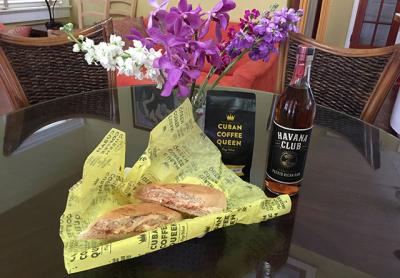Seasons by the Sea: The Lowdown on the Cuban Sandwich

Several cities in Florida claim to have invented the Cuban sandwich, but it is clear that it originated in Key West. Tampa, specifically Ybor City, a neighborhood of Tampa, inserts Genoa salami into their version, and the city council passed a bill in 2012 claiming the Cuban sandwich as theirs. Passing a bill doesn’t make it a fact, folks.
Some version of the Cuban sandwich, or mixto, or Cubano, was being made in Cuba hundreds of years ago. When cigar makers emigrated to Key West in the 1860s, it became popular as an easy, filling, portable meal. What goes into it? The sandwich traditionally starts with Cuban bread, a very specific, pale, fluffy, nondescript white loaf the size and shape of a large baguette, made with lard. A little bit of yellow mustard is smeared on the bread, some butter is optional. Next comes a little pile of shredded roast pork cooked in mojo, a marinade of sour orange juice, cumin, oregano, garlic, onions, vinegar, and salt. Then a slice or two of sweet ham (nothing too assertive, so as not to overwhelm the other white meat), along with three thin slices of pickle — no more, no less — and a slice of Swiss cheese to complete the sandwich. It is then pressed in a plancha (similar to a panini press but without the grill stripes). It is an odd-sounding mixture but can be oh, so delicious.
On this year’s adventure in Key West, I tried to sample as much Cuban food as I could. Not just Cuban sandwiches, but variations of Cuban coffee (cafecito, a tiny, potent, foamy cup with as much as a tablespoon of sugar added); pastelitos (puff pastry or Cuban bread filled with guava paste and cream cheese), and lots of rice and black beans. Being that my only mode of transpo was the ten-toe turbo — that is, walking — I wasn’t able to try every place on the island, but I tried enough to, one, get fat, and, two, find some awesome spots.
El Siboney has been a Cuban staple in Key West since 1984, named after the Siboney tribe of Cuba. The Taino and Siboney were prehistoric, self-sufficient, fishing, hunting, farming, and building wooden structures peoples. El Siboney has been rated Key West’s best Cuban restaurant every year since 1993. I think they are resting on their laurels. We tried two versions of chicken, the medio pollo a la plancha al ajillo and pechuga de pollo a la plancha, the first being a grilled garlic chicken, the second a grilled chicken breast. The garlic chicken was no more than very dried-out chicken with garlic salt on it. Same for the chicken breast, and no amount of sliced raw onions on top of them could moisten the dry meat. However, the fried plantains were good, as were the rice and beans. The rice was buttery, and the beans full of flavor, with bits of ham, onions, garlic, and other spices.
On to Cuban Coffee Queen, where the motto is “Drink more Cuban coffee and do stupid things faster.” Here, the Cuban sandwich was made with the addition of lettuce, tomato, and onion, considered sacrilege in some establishments, but I’ll take my vegetables where I can get them, especially when I’m already eating piglet squared. This version was very good, but the pork wasn’t tender enough to bite into; it just popped out of the sandwich with each bite. For $8.50, you get the sandwich and your choice of fruit or a bag of plantain chips, plus a DumDum lollipop.
Next stop, Havana Restaurant, where the sandwich is $13 and served with choice of potato salad, French fries, or wasabi coleslaw. This version was excellent! The pork was tender and flavorful, everything balanced nicely, and the sandwich benefitted from an addition of caramelized onions.
Five Brothers is a well-known but simple sandwich shop where the Cuban mixto sandwich is a mere $6.50, and it is very good, if a bit sparse with the fillings.
Next, it was time to get off the leash and try some Cuban mashups.
One of the best sandwiches I tried (and most dangerous for digestion) was the burger from Frita’s, supposedly based on 1930s Cuban street food. It is a beef and pork patty (I think the pork part is pure chorizo sausage), seasoned with garlic, onions, a spicy sauce, and fried potato strings, all on a Cuban bun. Frita’s recommended Manchego cheese on it, which was delicious. But as I observed the red-hot oil seeping out of the burger and dripping onto the plate, I said to it, “You’re going to come back later to haunt me, aren’t you?” The awesome Frita burger is $8.95.
In between sampling these not-so-healthy Cuban classics, I fried up some yellowtail snapper, cracked some stone crab claws, steamed some Key West pink shrimp, and blended fresh pineapple with bananas and mangoes for breakfast, and perhaps blended the same later in the day with a splash of dark rum. . . .
For an island that is a mere four miles long by one mile wide, Key West has a staggeringly huge number of restaurants. Estimates range from 454 to 700. I have my favorites: NineOneFive, Firefly, Blue Heaven, Onlywood, La Grignote. And I have those I avoid: Why go to a Hard Rock Cafe, like, ever?
I love this tiny island, the Conch Republic, the Rock. It is quirky and dirty, charming and alarming, sunny and “shady,” with an iguana in the backyard (Señor Verde) and a scorpion in the tub. I tell friends I come here for some sunshine and rum drinks and turquoise water, but really, I come for the people and their food.
